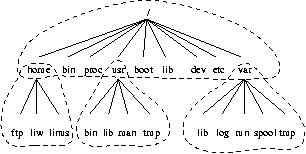This chapter is loosely based on the Filesystems
Hierarchy Standard (FHS)
[1]
version 2.1, which attempts to
set a standard for how the directory tree in a Linux
[2]
system is organised. Such a standard has the advantage that it will
be easier to write or port software for Linux, and to administer
Linux machines, since everything should be in standardised places.
There is no authority behind the standard that forces anyone to
comply with it, but it has gained the support of many Linux
distributions. It is not a good idea to break with the FHS without
very compelling reasons. The FHS attempts to follow Unix tradition
and current trends, making Linux systems familiar to those with
experience with other Unix systems, and vice versa.
This chapter is not as detailed as the FHS. A system
administrator should also read the full FHS for a complete
understanding.
This chapter does not explain all files in detail. The
intention is not to describe every file, but to give an overview of
the system from a filesystem point of view. Further information on
each file is available elsewhere in this manual or in the Linux
manual pages.
The full directory tree is intended to be breakable into
smaller parts, each capable of being on its own disk or partition,
to accommodate to disk size limits and to ease backup and other
system administration tasks. The major parts are the root
(/), /usr,
/var, and /home
filesystems (see Figure 4-1). Each part has a
different purpose. The directory tree has been designed so that it
works well in a network of Linux machines which may share some parts
of the filesystems over a read-only device (e.g., a CD-ROM), or over
the network with NFS.
The roles of the different parts of the directory tree are
described below.
The root filesystem is specific for
each machine (it is generally stored on a local disk,
although it could be a ramdisk or network drive as well) and
contains the files that are necessary for booting the system
up, and to bring it up to such a state that the other
filesystems may be mounted. The contents of the root
filesystem will therefore be sufficient for the single user
state. It will also contain tools for fixing a broken
system, and for recovering lost files
from backups.
The /usr filesystem
contains all commands, libraries, manual pages, and other
unchanging files needed during normal operation. No files in
/usr should be specific for any given
machine, nor should they be modified during normal use. This
allows the files to be shared over the network, which can be
cost-effective since it saves disk space (there can easily
be hundreds of megabytes, increasingly multiple gigabytes in
/usr). It can make administration
easier (only the master /usr needs to
be changed when updating an application, not each machine
separately) to have /usr network mounted. Even if the
filesystem is on a local disk, it could be mounted
read-only, to lessen the chance of filesystem corruption
during a crash.
The /var
filesystem contains files that change, such as spool
directories (for mail, news, printers, etc), log files,
formatted manual pages, and temporary files. Traditionally
everything in /var has been somewhere
below /usr, but that made it impossible
to mount /usr
read-only.
The /home
filesystem contains the users' home directories, i.e., all
the real data on the system. Separating home directories to
their own directory tree or filesystem makes backups easier;
the other parts often do not have to be backed up, or at
least not as often as they seldom change. A big
/home might have to be broken across
several filesystems, which requires adding an extra naming
level below /home, for example
/home/students and
/home/staff.
Although the different parts have been called filesystems
above, there is no requirement that they actually be on separate
filesystems. They could easily be kept in a single one if the
system is a small single-user system and the user wants to keep
things simple. The directory tree might also be divided into
filesystems differently, depending on how large the disks are, and
how space is allocated for various purposes. The important part,
though, is that all the standard names work;
even if, say, /var and
/usr are actually on the same partition, the
names /usr/lib/libc.a and
/var/log/messages must work, for example by
moving files below /var into
/usr/var, and making /var
a symlink to
/usr/var.
The Unix filesystem structure groups files according to
purpose, i.e., all commands are in one place, all data files in
another, documentation in a third, and so on. An alternative would
be to group files files according to the program they belong to,
i.e., all Emacs files would be in one directory, all TeX in another,
and so on. The problem with the latter approach is that it makes it
difficult to share files (the program directory often contains both
static and sharable and changing and non-sharable files), and
sometimes to even find the files (e.g., manual pages in a huge
number of places, and making the manual page programs find all of
them is a maintenance
nightmare).

